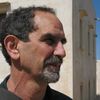At the Port-au-Prince airport, as at most airports in poor countries, men are hustling to carry luggage and hook up travelers with taxis. I'm looking for Schendy, the young architect from Architecture for Humanity who's coming to meet me. All the hustlers say of course they know him and compete desperately to carry my luggage out to meet him.
Finally I find him in the crush at the gate, a wiry, energetic Haitian-American with hints of Philadelphia in his accent. He lugs my big plastic tub full of electrical tools and materials for photovoltaic panels to the waiting SUV.
The driver takes a route around the periphery of the city -- the center of town is impassible --traversing the hills and ravines on the edge of town.
From the air, Port-au-Prince looks like someone took an enormous hammer and started smashing the place at random. Gou-Dou-Gou-Dou -- the nickname people have bestowed on the January 12 earthquake because of the sound it made -- destroyed around three-quarters of the city. The official figure is that over 220,000 people lost their lives.
Driving across the city, no neighborhood seems to have been spared. But the destruction is patchwork: blocks with no visible damage stand next to areas that have been leveled; intact houses are flanked by sprawling heaps of rubble. Tent cities and tarpaulin camps throng parks and hillsides.
The streets are squeezed on both sides by pedestrians, vendors and businesses spilling out from the ruins. So traffic is constricted into a continuous one-lane game of chicken, trying the patience of even the stoic Haitians.
The damage reportedly extends far to the west and south, where the epicenter was located, decimating smaller cities like Leogane on the Bay of Port-au-Prince and Jacmel on the southern coast.
Architecture for Humanity, an international non-profit based in San Francisco, has rented a big house on a steep side street above the road from Pétionville up to Kenscoff in the hills. It's a little cooler up here than in the flats of Port-au-Prince, and at night the frogs and insects sound like thousands of cell phones calling each other.
The house belongs to a family of five that has moved to Miami. It looks like they were economically comfortable: big rooms, tall ceilings, terrazzo floors, bathrooms with toilet, shower and bidet, several big bookcases and armoires of varnished dark wood with l'Encyclopédie Grolier on a shelf of one.
A group of young Canadians doing volunteer work here is staying at the house for a few days. The leader, Chrystal, is living in the Dominican Republic. Her next-door neighbor there, a quiet, serious young Haitian named Junior, has come along with group.
Junior comes from Cap Haïtien in the north of the country, which was not hit by the quake. He's studying engineering at a university in the DR, which he says has better schools than Haiti. His classes are all in Spanish, but he's taking a lot of math and physics in which he says the language doesn't make so much difference. Virtually all Haitian families speak Kreyol, and school is in French, but Junior says that Spanish is often taught as a second language. He speaks French in a soft voice, and his analysis is unflinching.
Crossing back into Haiti is painful for Junior. On the Dominican side it's almost like the U.S. or Europe, he says, but when you cross into Haiti everything is broken and poor. Why is that?
They build big buildings in the DR, and foreign companies may design them, but the people doing the construction are all Haitians. Why can't we do that at home?
People in the DR are nice to him because he's a university student, but he sees a lot of prejudice there as well. Some Dominicans say Haitians have darker skin. For many decades, Haitian farmworkers have migrated over to work in the Dominican bateys, the sugar-cane plantations. The conditions they endure there often border on slavery, according to human rights groups.
Back in Haiti, the government is struggling. About a quarter of public employees died in the quake, Junior estimates, and nearly all government buildings were destroyed.
Back in the '90s, after civilian rule was restored in the wake of decades of dictatorship, then-President Jean-Bertrand Aristide abolished the army. In retrospect, Junior believes, this has created problems. The training and readiness of the police had improved, but now many of them have been killed by the earthquake as well. Even before the quake, the primary responsibility for security has been shouldered for several years by MINUSTAH, the military mission of the United Nations.
A few days after the quake, with the National Palace in ruins, media reports described President René Préval as "homeless". Listening to him on TV and the Internet, he sounds overwhelmed and exhausted by the situation and the loss of much of his government. Although by most accounts the former agronomist is honest and capable, Junior sees him as a weak leader at a time when Haiti needs someone dynamic to restart the country. When Préval was speaking to a group of desperate and hungry earthquake victims, Junior says, he told them: "I'm hungry too."
